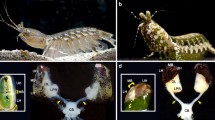Summary
The fine structure of the small compact ocelli (50–100 μm in diameter) of Polyorchis penicillatus is described. The ocellar cup is formed of pigment cells and receptor cells. The pigment cells occur in approximately a 2:1 ratio to the receptor cells. Each pigment cell has a process that may pass through the presumed photosensory region. Pigment cells are connected to adjacent receptor cell processes by septate junctions. The sensory cells are bipolar with the apical part forming the receptor process and the basal part forming an axon 8–15 μm long and 1–2 μm in diameter. Each receptor cell axon forms a synapse with a single second order neuron but the sensory cells are also connected to the second order neurons postsynaptically. There are also synapses between adjacent second order neurons. The second order neurons lie outside the ocellar cup, next to the tentacular mesogloea. Each second order neuron forms an axon of about 1 μm thickness. The axons on each side group together to form an optic nerve having 30–40 axons that travel around the tentacle base on either side and enter the outer nerve ring independently.
Similar content being viewed by others
References
Anderson PAV, Mackie GO (1977) Electrically coupled, photosensitive neurons control swimming in a jellyfish. Science 197:186–188
Bouillon J, Nielsen M (1974) Etude de quelques organes sensoriels de cnidaires. Archs Biol (Bruxelles) 85:307–328
Eakin RM, Westfall JA (1962) Fine structure of photoreceptors in the hydromedusan, Polyorchis penicillatus. Proc Natl Acad Sci (Wash) 48:826–833
Eakin RM, Westfall JA (1964) Further observations on the fine structure of some invertebrate eyes. Z Zellforsch Mikrosk Anat 62:310–332
Eschscholtz F (1829) System der Acalephen. Eine ausführliche Beschreibung aller medusenartiger Strahltiere. Ferdinand Dümmler Berlin, pp 1–190
Mackie GO (1971) Neurological complexity in medusae: A report of central nervous organization in Sarsia. Actas del 1° Simposio Internacional de Zoofilogenia, Salamanca. Univ of Salamanca, pp 269–280
Singla CL (1974) Ocelli of hydromedusae. Cell Tissue Res 149:413–429
Toh Y, Yoshida M, Tateda H (1979) Fine structure of the ocellus of the hydromedusan, Spirocodon saltatrix. I. Receptor cells. J Ultrastruct Res 68:341–352
Weber C (1981a) Structure, histochemistry, ontogenetic development, and regeneration of the ocellus of Cladonema radiatum Dujardin (Cnidaria, Hydrozoa, Anthomedusae). J Morphol 167:313–331
Weber C (1981b) Electrical activities of a type of electroretinogram recorded from the ocellus of a jellyfish, Polyorchis penicillatus (Hydromedusae). J Exp Zool (Submitted)
Yamamoto M, Yoshida M (1980) Fine structure of ocelli of an anthomedusan Nemopsis dofleini, with special reference to synaptic organization. Zoomorphology 96:169–181
Yamasu T, Yoshida M (1973) Electron microscopy on the photoreceptors of an anthomedusa and a scyphomedusa. Publ Seto Mar Lab 20:757–778
Author information
Authors and Affiliations
Rights and permissions
About this article
Cite this article
Singla, C.L., Weber, C. Fine structure studies of the ocelli of Polyorchis penicillatus (Hydrozoa, Anthomedusae) and their connection with the nerve ring. Zoomorphology 99, 117–129 (1982). https://doi.org/10.1007/BF00310304
Received:
Issue Date:
DOI: https://doi.org/10.1007/BF00310304




